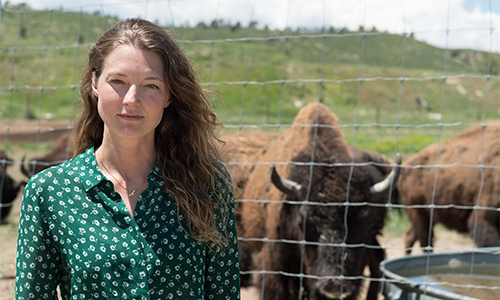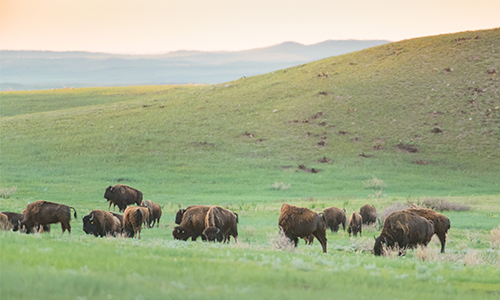Northern Colorado Bison Herd
Flourishes
story by Mary Guiden
published July 8, 2019
On a recent sunny day in Northern Colorado, a team from Colorado State University and the City of Fort Collins released eight bison on the windswept plains of the Soapstone Prairie Natural Area and the Red Mountain Open Space.
“It never gets old,” said CSU’s Jennifer Barfield as the majestic animals started to explore their new home, lumbering their way to join the rest of the Laramie Foothills Bison Conservation Herd.
The Laramie Foothills Bison Conservation Herd was established with nine females and one male calf in November 2015. The bison had valuable genetics from the Yellowstone National Park Herd and — thanks to science implemented at CSU — the animals were also disease-free.
Not even four years later, there are now 76 bison. The success of this conservation effort astounds even those closest to the project, including Barfield, who serves as the scientific lead and is a reproductive physiologist.
“It is incredibly exciting and fulfilling to see the partnerships we’re forming, and the way we’re able to share our bison with tribal and conservation herds, which is really what we intended,” she said. “What’s really surprised me is how quickly we’ve gotten to this point, and part of that is due to how well the animals are doing. They’re reproducing well and they’re just healthy, in general.”
New partners sustain, honor bison
Over the last few years, the project’s partners — CSU, the City of Fort Collins and Larimer County — have contributed bison to conservation efforts across the U.S. This includes teaming up with the Minnesota Zoo, which is helping to restore bison to some of the state park systems in that state, and the Pueblo of Pojoaque tribe in New Mexico, which manages bison on the Rio Mora National Wildlife Refuge, in partnership with the Denver Zoo.
Earlier this month, two bulls from the herd were delivered to the Oakland Zoo, where they will breed with female bison from the Blackfeet Nation, which partners with the zoo on its Iinnii Initiative, which aims to conserve traditional lands, protect Blackfeet culture and create a home for the buffalo. These female bison are from the Elk Island National Park in Alberta, Canada, and are descendants from animals captured on the Blackfeet land in the late 1800s.
The calves that are produced will go back to the reservation and live on the natural landscape in Montana. The bulls will follow suit, after a few years of breeding at the zoo.
Teri Dahle, coordinator for the Iinnii Initiative, said that the return of the buffalo to native lands provides hope for members of the Blackfoot Confederacy, which includes the Blackfeet Nation-Amaskapi Piikuni-Montana, Kainai – Blood Tribe-Alberta, North Peigan- Piikani Nation-Alberta and Siksika Nation-Alberta.
“It’s so important for us to have these buffalo, for many reasons, but most importantly for our spirituality,” she said.
“It’s so important for us to have these buffalo, for many reasons, but most importantly for our spirituality.”
— Teri Dahle, coordinator for the Iinnii Initiative
Photo by William A. Cotton
At one point, more than 30 million buffalo freely roamed the tribal lands, but populations neared extinction in the 1870s and 1880s due to the slaughter of wild buffalo by settlers.
“Our whole lifestyle changed at that moment,” Dahle said.
She hopes the partnership will also provide educational opportunities for tribal youth. “They can be exposed to what it might be like to be a veterinarian, conservationist or zoologist,” she said. “Our youth could see the connections and the scientific part of the project, too.”
The new project has additional ties to Fort Collins. Dr. Joel Parrott, a veterinarian and CSU DVM program alumnus, is the president and CEO of Oakland Zoo.
“I am excited to partner with my alma mater to bring Yellowstone Park ancestry to Oakland Zoo’s California Trail,” he said, referring to a 56-acre park in the zoo dedicated to iconic species, including bison. “Introducing these two bulls to our female herd will bring a more diverse and strong genetic line to the animals we release to be free-ranging on Blackfeet tribal land and U.S. and Canadian national parks through the Iinnii Initiative.”
Meegan Flenniken, division manager of Land Conservation, Planning & Resource with Larimer County, said her team is thrilled that the conservation goals of the Laramie Foothills herd continue to be realized.
“The proven success of this project is not only to re-introduce bison to northern Colorado at Red Mountain Open Space and Soapstone Prairie Natural Area, but ultimately for animals from that herd to help establish herds elsewhere,” she added.



Jennifer Barfield, assistant professor in the College of Veterinary Medicine and Biomedical Sciences, says the growth of the herd has allowed them to share bison with tribal and conservation groups. Photos by William A. Cotton
Barfield said that the two bulls who recently left the herd are quite special since they were among the first group of calves born on the prairie in Northern Colorado.
“They’re our first generation of babies that are now going out and contributing to other herds,” she said. “We watched these guys grow from tiny little red calves and now, they’re big bulls, ready to go out and start contributing their genetics to the herd and to other herds outside ours. It’s rewarding but it’s always sad to see them go.”
Zoe Shark, public engagement manager for the City of Fort Collins natural areas, noted that the herd has had a major impact in the region and beyond, through social media.
“We’ve all been able to see how the community has been engaged, and really care about these animals and where they go, and how they’re contributing to conservation not only here, but outside of Colorado,” she said. “We have a lot of people who are interested in the bison and in learning more about them, their history and role in the ecosystem.”
Celebrate Soapstone Prairie Natural Area, Red Mountain Open Space July 13
The City of Fort Collins and Larimer County will host a 10th anniversary celebration of Soapstone Prairie and Red Mountain Saturday, July 13. The event is free and open to the public and will include a ceremony and interactive educational stations for people to learn more about the animals, geology and wildflowers. The ceremony starts at 10 a.m. at Soapstone Prairie Natural Area’s south parking lot picnic shelter. Visit the educational stations from 10:30 a.m. to 2 p.m.
Van transportation to Soapstone Prairie is available at no charge, but registration is required. Parking is limited, so carpooling is also encouraged. Learn more on the City of Fort Collins’ website.